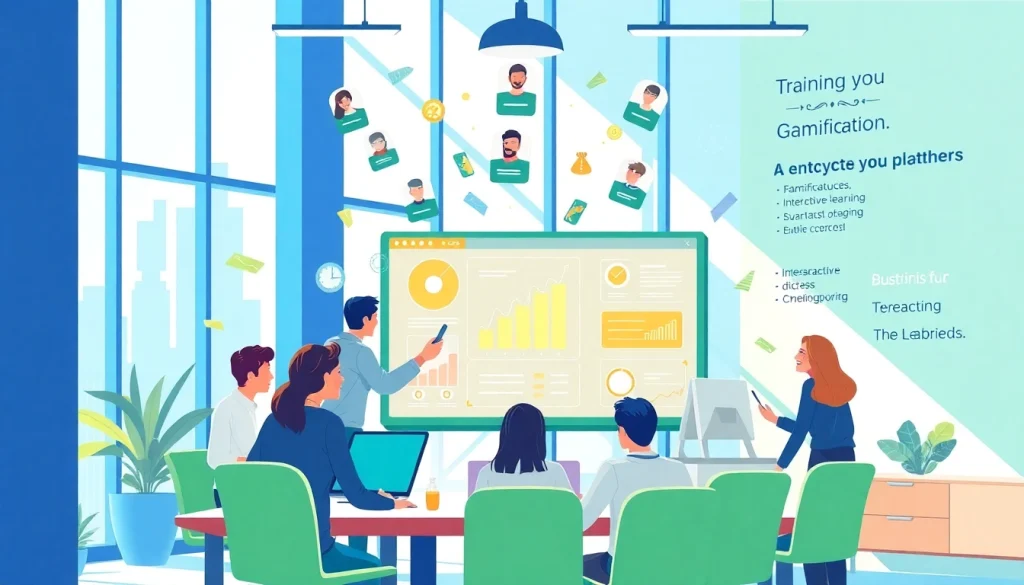Understanding Training Gamification
What is Training Gamification?
Training gamification refers to the integration of game-like elements into educational environments to enhance the training experience and improve learner engagement. By employing techniques such as point scoring, competition, and rewards, organizations aim to transform mundane learning tasks into exciting challenges. This innovative approach leverages the intrinsic motivation that games naturally evoke, making the learning process more enjoyable and interactive.
As organizations strive to maintain an edge in knowledge and skills across their workforce, gamification has emerged as a pivotal strategy in the realm of employee training. By focusing on training gamification, businesses can tap into the power of immersive experiences that not only impart knowledge but also cultivate a sense of camaraderie and healthy competition among employees.
Benefits of Incorporating Gamification in Training
The incorporation of gamification into training programs yields substantial benefits, including:
- Engagement and Motivation: Gamified training encourages active participation, thus fostering a greater commitment to learning by making it more entertaining and interactive.
- Improved Knowledge Retention: Gamification enhances recall by associating information with activities and challenges that facilitate repeated exposure and practice.
- Immediate Feedback: Participants gain instant feedback on their performance, helping them identify areas needing improvement and promoting a growth mindset.
- Team Collaboration: Gamified elements can encourage teamwork and collaboration, making learning a collective effort rather than an isolated task.
- Attracting a Diverse Audience: Gamification appeals not just to younger employees familiar with gaming culture, but to a wider demographic, making training programs accessible and appealing to all ages.
- Measurable Progress: Organizations can track engagement levels and performance through leaderboards and progress metrics, allowing for more personalized training experiences.
Common Misconceptions about Gamification
Despite the effectiveness of gamification, several misconceptions can hinder its successful implementation in training:
- Gamification is Only About Fun: While making learning enjoyable is a key aspect, the primary goal of gamification is to achieve specific educational outcomes.
- It’s Only for Younger Audiences: Although appealing to younger generations, the benefits of gamification transcend age groups, enhancing learning for everyone involved.
- Gamification Means Wrongful Competition: When implemented correctly, gamification promotes healthy competition which can boost motivation rather than encourage negative outcomes.
- All Learning Objectives Can be Gamified: Not every training program is suitable for gamification. Clear learning objectives must exist to align game mechanics effectively.
Elements of Effective Gamification
Key Game Mechanics to Enhance Learning Engagement
Incorporating the right game mechanics is vital for the success of gamified training. Here are some fundamental elements:
- Points: Employees earn points for completing tasks, which serve as a tangible measure of accomplishment and progress.
- Badges: Badges recognize achievements, providing a sense of identity and accomplishment that can be shared within and outside the organization.
- Leaderboards: These foster competitive spirit by ranking employees based on points earned, prompting them to strive for higher rankings.
- Challenges and Quests: Presenting problems or scenarios that require creative and collaborative solutions can enhance engagement.
Balancing Fun with Educational Objectives
It’s crucial for an effective gamification strategy to balance entertainment with the educational goals of training. Fun elements should not overshadow learning objectives—a common pitfall that can lead to an ineffective training program. To strike this balance, instructional designers must carefully align game mechanics with clear learning outcomes, ensuring every game-like element contributes to the overarching goal of knowledge transfer and skill acquisition.
Integrating Feedback Mechanisms
Feedback is a key player in the learning process, especially in a gamified environment. Continuous feedback helps learners understand both their strengths and areas for improvement. Effective gamification incorporates various feedback mechanisms that might include:
- Instant Feedback: Providing real-time feedback on tasks helps learners adjust their strategies promptly.
- Peer Feedback: Encouraging employees to provide constructive criticism promotes a culture of collaboration and continuous improvement.
- Performance Reports: Regularly sharing performance reports can motivate learners by showcasing progress and highlighting accomplishments.
Implementing Training Gamification in Your Organization
Step-by-Step Guide to Start Gamifying Training
To implement training gamification effectively, follow these steps:
- Define Objectives: Start by clearly defining the outcomes you wish to achieve with gamification. What skills or knowledge should employees acquire?
- Engage Stakeholders: Involve key stakeholders, including employees, managers, and training experts, to gather insights and expectations.
- Select Appropriate Game Mechanics: Choose game mechanisms that align with the defined objectives and the needs of your audience.
- Design the Training Program: Develop the actual learning content, ensuring it integrates the chosen gamified elements seamlessly.
- Launch and Pilot: Implement the training program with a small group before a wider rollout, gathering feedback for enhancements.
- Evaluate and Iterate: Continuously assess the effectiveness of the program through feedback and engagement metrics, making necessary adjustments.
Identifying Suitable Gamification Tools
Choosing the right tools is essential for an effective gamification strategy. With numerous options available, it’s vital to assess the following factors:
- Ease of Integration: The tools should easily integrate with existing learning management systems (LMS) and workflows.
- User-Friendly Interface: Both trainers and participants should find the tools intuitive and straightforward to use. The user experience greatly influences engagement levels.
- Scalability: Tools should be scalable, accommodating your organization’s growth and evolving training needs.
- Analytics Capabilities: Effective gamification tools provide detailed analytics to monitor engagement, progress, and outcomes.
Developing a Pilot Program
A pilot program is crucial to test your gamified training approach before a full-scale launch. Consider the following steps in developing a pilot:
- Select a Target Group: Choose a representative sample from your workforce to participate in the pilot program.
- Set Clear Metrics: Define success criteria for the pilot, such as engagement levels, learning outcomes, and satisfaction ratings.
- Gather Feedback: Collect qualitative and quantitative feedback from participants during and after the pilot phase to gauge its effectiveness.
- Refine the Program: Analyze the feedback and performance data to identify necessary changes to improve the training experience.
Measuring the Impact of Gamified Training
Defining Key Performance Indicators (KPIs)
To evaluate the success of your gamified training programs, it’s essential to define clear KPIs. Common KPIs may include:
- Engagement Rates: Measures the participation levels during training.
- Completion Rates: Tracks the percentage of participants completing the training.
- Knowledge Retention: Assesses how well participants can recall and apply knowledge gained from the training.
- Employee Satisfaction: Surveys can measure participants’ satisfaction and perceptions of the training program.
Analyzing Employee Engagement and Learning Retention
Once you’ve set KPIs, you need to consistently analyze employee engagement and learning retention. Evaluating metrics against your objectives will help ascertain whether your gamified training is effective. For instance, if your program’s goal is to improve product knowledge, testing employees before and after the training can reveal knowledge gain.
Additionally, tools like Learning Management Systems (LMS) can provide valuable insights into learner progress, identifying patterns that demonstrate engagement or areas of concern that might need addressing.
Collecting Feedback for Continuous Improvement
Feedback should not be a one-time event but rather an ongoing part of the training lifecycle. Collecting participant feedback both during and after the program helps refine the experience and increase effectiveness over time. Consider various methods:
- Surveys and Polls: These can gauge participant satisfaction and gather suggestions for improvement.
- Focus Groups: Engaging groups of participants can facilitate deeper discussions about their experiences and insights.
- Usage Analytics: Collect data from gamification tools to track engagement metrics, helping identify both successes and areas needing enhancement.
Future Trends in Training Gamification
Emerging Technologies Enhancing Gamified Learning
The future of training gamification looks promising, with advancements in technology paving the way for innovative methods of engagement. Virtual and augmented reality, for example, are becoming increasingly effective in immersing learners in realistic training scenarios. This can enhance emotional engagement and provide more hands-on experience, fostering deeper learning and retention.
Personalization in Gamification Strategies
As personalization becomes a focal point in various industries, gamification in training is no exception. Tailoring gamified experiences to individual learning preferences, speeds, and goals can significantly increase engagement. Personalized pathways allow learners to take control of their training journey, making it more meaningful and relevant.
The Role of Virtual Reality in Training Gamification
Virtual reality (VR) is revolutionizing how organizations approach training gamification. By creating immersive environments that simulate real-world challenges, VR training can lead to higher retention and more effective skill application. For example, corporate training can utilize VR for simulations that allow employees to practice complex technical skills without the risk associated with real-world applications. The possibilities for VR in gamified training are vast, opening up innovative avenues for skill development.



